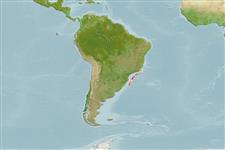ইলাসমোব্রাঙ্কি (হাঙ্গর এবং রে) (sharks and rays) >
Torpediniformes (Electric rays) >
Narcinidae (Numbfishes)
Etymology: Benthobatis: Greek, benthos = depth of the sea + Greek, batis, -idos = a ray (Raja sp.) (Ref. 45335).
Environment: milieu / climate zone / depth range / distribution range
বাস্তুসংস্থান
সামুদ্রিক ব্যথিডিমারসাল সমুদ্র তলদেশবিহারী; গভীরতার পরিসীমা 420 - 527 m (Ref. 57911). Deep-water; 20°S - 45°S, 55°W - 40°W (Ref. 57911)
Southwest Atlantic: off southern Brazil.
আকৃতি / ওজন / Age
Maturity: Lm ? range ? - ? cm
Max length : 30.0 cm TL পুরুষ/ লিঙ্গ অনিধর্ারিত ; (Ref. 57911)
Deep water species on the continental slope. Feeds on worms, isopods and amphipods. The late-term embryos seem to gestate in a combined uterine/cloacal chamber. Produces up to 2 pups during each pregnancy. Maturity size of males at ca. 15 cm TL, females at 20 cm TL; birth size at ca. 10 cm TL. It is reported to be locally abundant as many individuals have been collected together in a single trawl (Ref. 114953).
Life cycle and mating behavior
পরিপক্কতা | প্রজনন | ডিম ছাড়া | ডিমসমূহ | ডিম্বধারন ক্ষমতা | শুককীট
There are indications that this species is ovovivipar (Ref. 57911).
Eschmeyer, W.N. (ed.), 2003. Catalog of fishes. Updated database version of March 2003. Catalog databases as made available to FishBase in March 2003. (Ref. 46206)
IUCN Red List Status (Ref. 130435)
Threat to humans
Harmless
Human uses
মৎস্য: আকর্ষণবিহীণ
আরো তথ্য
Age/Sizeবৃদ্ধিLength-weightLength-lengthLength-frequenciesমরফোমেট্রিক্সবহিঃ অঙ্গ সংস্থানশুককীট শুককীটের সত্রিুয়তা নির্বাচন প্রাচুর্য BRUVS
সূত্র সংখ্যা এ্যাকুয়াকালচার (জলজ পালন) এ্যাকুয়াকালচার নকশা বংশ বংশানুগতিবিদ্যাElectrophoresesউতরাধিকার সুত্রে পাওয়া যোগ্যতারোগ প্রক্রিয়াজাতকরণ NutrientsMass conversion
সহযোগী ছবি সমূহStamps, Coins Misc.শব্দ ক্রোমোজোমের ধরণ গতি সাতাঁরের কায়দা ফুলকা এলাকাOtolithsমস্তিস্ক সমূহদৃষ্টি
হাতিয়ার
Special reports
Download XML
ইন্টারনেট সুত্র
Estimates based on models
Preferred temperature (Ref.
123201): 3.3 - 15.6, mean 6.9 °C (based on 37 cells).
Phylogenetic diversity index (Ref.
82804): PD
50 = 0.5625 [Uniqueness, from 0.5 = low to 2.0 = high].
Bayesian length-weight: a=0.01175 (0.00476 - 0.02897), b=2.88 (2.66 - 3.10), in cm total length, based on LWR estimates for this (Sub)family-body shape (Ref.
93245).
ট্রফিক পর্যায়ে (Ref.
69278): 3.2 ±0.46 se; based on food items.
স্থিতিস্থাপক (Ref.
120179): অত্যন্ত কম , সর্বনিম্ন প্রজন দ্বিগুনের সময় ১৪ বৎসর (Fec=1-2).
Fishing Vulnerability (Ref.
59153): Low vulnerability (20 of 100).
